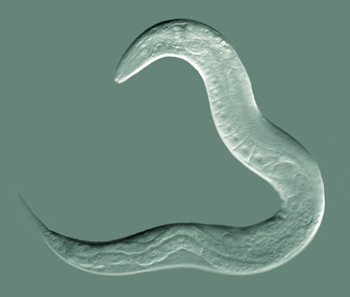by Piter Kehoma Boll
Despite its small size, today’s fellow is one of the most important organisms in current scientific research. Named Caenorhabditis elegans and usually called simply C. elegans, this worm is a nematode and reaches about 1 mm in length and lives in the soil of temperate areas.

There are only four bands of muscles that run along the body of C. elegans and they only alow the worm to bend the body dorsally or ventrally, but not to the sides. Thus, while moving on a horizontal surface, the worms are forced to lie on their left or right side.
The main food source of C. elegans are bacteria that live on decaying organic matter, although they can also feed on some yeast species. Therefore, they thrive in soils rich in organic matter, where bacteria occur in abundance.
The sex of C. elegans is unusual. An adult organism can be either a male or a hermaphrodite, without a pure female form. Hermaphrodites are the most common form and usually self-fertilize, although they can, and apparently prefer, to mate with males. The larvae pass through four larval stages before reaching the adult stage, but this happens very quickly, since in ideal conditions the lifespan of C. elegans is of about 2 to 3 weeks. However, in conditions of insufficient food, an alternative third larval stage called dauer can be formed. The dauer stage has the body sealed, including the mouth, which doesn’t allow it to take in food, and can remain as such for a few months until the conditions are good again.
As most nematodes, C. elegans presents eutely, i.e., the adult worm has a genetically determined number of cells in the body. This number is fixed and does not change, because cell division ceases in adults. Male C. elegans have 1031 cells and hermaphrodites have 959 cells.
Due to its small size, small and fixed number of cells, transparent body and because it is easy to raise it in the lab, C. elegans became a perfect model organism. It was the first organism to have its genome fully sequenced and up to now it is the only organism with a complete connectome (the map of his neuron connections). It has been used in studies related to ageing, development, apoptosis and all sort of gene expressions.
– – –
– – –
References and further reading:
Brenner, S. (1974) The genetics of Caenorhabditis elegans. Genetics 77(1): 71-94.
Klass, M. R. (1977) Aging in the nematode Caenorhabditis elegans: Major biological and environmental factors influencing life span. Mechanisms of Ageing and Development 6: 413–429. https://doi.org/10.1016/0047-6374(77)90043-4
Peden, E.; Killian, D. J.; Xue, D. (2008) Cell death specification in C. elegans. Cell Cycle 7(16): 2479–2484. https://doi.org/10.4161/cc.7.16.6479
Wikipedia. Carnorhabditis elegans. Available at < https://en.wikipedia.org/wiki/Caenorhabditis_elegans >. Access on April 16, 2018.
– – –

*
This work is licensed under a Creative Commons Attribution-ShareAlike 3.0 Unported License.

Pingback: Male resistance: when females disappear and hermaphrodites don’t like you | Earthling Nature
Pingback: Friday Fellow: Common Water Flea | Earthling Nature